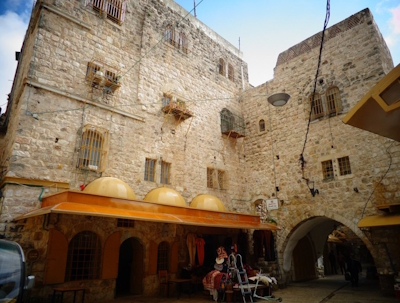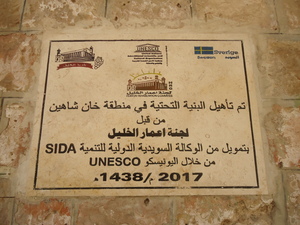Hebron/Al-Khalil Old Town

Hebron/Al-Khalil Old Town is a well-preserved urban fabric that developed during the Mamluk and early Ottoman periods.
The town developed around the Cave of the Patriarchs / Sanctuary of Abraham / Ibrahimi Mosque, a compound dating to over 2,000 years ago and associated with the Holy Books Torah, Bible and Quran. It is a site of pilgrimage for the three monotheistic religions: Judaism, Christianity and Islam.
Community Perspective: This lies in an area under Israeli control. There are 2 entrances to the compound at opposite sides, one for Jews and one for Muslims. People from other religions are allowed to enter from both sides, and you’d do so “for religion or curiosity”, it’s not an “architectural experience”. The surrounding area “is as dead as an abandoned gold rush town on the West Coast”.



Map of Hebron/Al-Khalil Old Town
Community Reviews
J_neveryes

If you spend some time to explore Hebron, you will find a city where its resident do their best to live a life of normalcy despite Israeli military control and restriction on freedom of movement and economic activities.
We visited the city of Hebron by public bus from Jerusalem - you can find the buses that go to the West Bank at a bus station near the Damascus Gate. The bus dropped us off in the commercial centre of Hebron, near and within walking distance of the old city. Although we did get lost initially, with the help of residents and shopkeepers, we eventually found the spot where we were to meet our local guide. Our guide was Hisham Sharabati, a Palestinian political analyst and human rights worker. As I only had passing knowledge of the historical and political context of the region, I greatly appreciated the expertise of our wonderful host.
The old city of Hebron was both quiet and bustling. Quiet in that good portions of the neighbourhood was closed due to military orders, but bustling in that the residents were trying to rejuvenate the portions of the city that they still had control over (the photo attached to this review is of a shopkeeper in the old city).
We also visited the Tomb of the Patriarchs or more specifically the Ibrahimi Mosque portion of the Tomb. The Tomb/Mosque looks more imposing from the outside. The inside of the Mosque is more austere than one may expect for a place with such religious and historical significance.
People often ask me about safety when they learn that I visited Palestine/West Bank (We also visited Ramallah, Bethlehem, and Wadi Qelt). While I can't comment on the situation currently, I can confirm that we felt very safe in 2017. People were incredibly helpful and friendly, and we did not hesitate to explore the city independently after we parted ways with our guide. What was bitterly ironic was that I - a foreigner with absolutely no ties to the land - was able to move more freely and explore more of the city than the Palestinians who actually lived in the city.
Nan

"What's your religion?" I stood at the entry to the Muslim side of the Cave of the Patriachs/Ibrahimi Mosque and an IDF soldier was asking. I answered: "None, I am an atheist." He was befuddled and repeated the question: "Sorry, but what is your religion?" Again, I truthfully answered "None." At this point, he concluded that asking me for my religion wasn't going anywhere. "Okay, what's the religion of your parents?" Honest answer would have been "None" again. Understanding that he needed an answer, I asserted that they were Christians, culturally. This made him happy, and he allowed me to enter to the site.
The main site of Hebron is the Cave of the Patriarchs/Ibrahimi Mosque which is 2.000 years old and a structure dating back to Herodot, i.e. pre-Roman. The belief is that Abraham and his kin are buried here. Muslims in addition believe that Mohammed stopped here, before ascending to the Heavens in Jerusalem.
The structure has undergone several changes from a Jewish temple to a Byzantine church to a mosque and back to a church. In modern times, the site is primarily a mosque with a Jewish place of prayer attached to the side. Both faiths have a view of the tombs and the underlying cave. As "Christian", you are allowed to explore both the Islamic mosque as well as the attached Jewish synagogue.
While the structure is impressive, as an atheist I find it hard to ignore how much violence is caused by it and similar structures in the Holy Land. Any rational human being would not want to live amid 150.000 Palestinians who are openly hostile to your presence. But some 500 orthodox Jewish settlers (i.e., colonists) have made a different call due to religious reasons. Apparently, Hebron is the entry to the Garden of Eden and plays a key role in the messianic Age of Redemption.
Practically, the Jewish minority can only live in Hebron, because a massive IDF detachment protects their enclave 24x7. I don't see how a peace process in this constellation can ever succeed and that was as depressing a take-away as they get for a world heritage site.
With this background, it's hard to get to a neutral assessment of the OUV of the site. I think a pre-Roman temple warrants inscription on its own. We only got glimpses of the old town, but I found Bethlehem to be more impressive in comparison.
Getting There
Easiest option is getting a cab at Checkpoint 300 or in Bethlehem. You can include a short stop at Battir and tick off all of Palestine's current WHS in a day. Cost should be 250-300 NIS (75€). While Palestinians are a great bunch (friendly and open), they are still cabbies. So: Agree up front on price and itinerary. And don't change the itinerary midway as cost may go up significantly.
If you don't want to take a cab, thanks to the Jewish community, there are direct bus connections from Jerusalem and probably also Beer Scheva. Note: You need to be Christian to be able to roam freely in Hebron.
There are servis back to Bethlehem, so you can visit both sites in a day with public transport. Battir meanwhile will be hard to do.
While You Are There
Situation in Hebron is tense. The day after our visit there was yet another incident, this time with a leftist Israeli protester. I would recommend keeping it brief and heading back to Bethlehem which I found way more pleasant overall.
DL

Cave of the Patriarchs
Dating back two thousand years ago, the two-metre thick stone wall which forms the exterior of the Cave is the only fully intact Herodian structure and one of the oldest buildings that still serves its original function. The Byzantine built a roof and turned it into a church; after changing hands from the Muslims to the Crusaders then back to the Muslims, Saladin remodelled the enclosure into a mosque in 1188. The caves, holding the tombs of the patriarchs and their wives, are closed off since the 1490s, forcing pilgrims to project their imaginations onto the respective cenotaphs instead.
For 700 years Jews were forbidden to enter — the closest they could get was up to the seventh step of an outer staircase. Jews began to migrate back to Hebron following the Six-Day War and at long last regained access to the Cave of the Patriarchs, although it continues to be managed by an Islamic charitable trust. Sharing a holy site proved to be anything but smooth, resulting in four attacks targeting Jews from 1968 to 1980, and after a period of calm, a massacre of 29 Palestinians at the hand of a radicalized Brooklyn-born Jew called Baruch Goldstein in 1994. Curfew was imposed on Hebron for two months, disproportionately affecting the Palestinians. Goldstein’s grave has inexplicably become a pilgrimage site for Jewish extremists.
As prevention of further bloodshed the Cave has since been split into two, creating a bizarre scenario where foreigners can access the entire site yet locals are limited to their own spheres the majority of the time — each side gains full control for ten days each year. Is the segregation necessary? The Palestinians are rightfully upset; why should they concede their right to the Cave when they were the victims, but the Israelis point to the fact that no violence has taken place inside the site as proof that this policy is a success.
The Jews have access to the northern section, including the cenotaphs of Jacob and Leah; Abraham’s and Sarah’s lie in two rooms in the middle, visible from both sides; the Ibrahimi mosque contains the remaining two cenotaphs and is the largest of the three sections. Architecturally the 800 year old mosque, with several surviving elements from the 12th-century Crusader church, is much more interesting than the Jewish rooms, which looks like they are hastily assembled.
Hebron Old Town (Palestinian side)
The immediate area surrounding the Cave of the Patriarchs used to be a lively commercial district, yet today it is as dead as an abandoned gold rush town on the West Coast. The IDF (Israeli Defence Force) evacuated the surrounding community after the massacre in 1994, ostensibly as a security measure to prevent retaliation. But judging what has transpired since, it seems more plausible the ultimate aim is to set up a Jewish area that links the Cave of Patriarchs with the Avraham Avinu and Kiryat Arba settlements. Blockades are set up, affecting mostly Palestinians, including school children a few hours ago.
The Israeli side
We continued to explore Avraham Avinu, a settlement right at the heart of Hebron’s historic centre. Approaching the gated community, we come across a deserted square which in a past life was a busy market catered to pilgrims. Now the only thing of note is a plaque commemorating the murder of Shlomo Yitzhak Shapira, who was killed in a terrorist attack in 2002. At the gate of Avraham Avinu is another memorial — a 10-month-old baby named Shalhevet Pass was gunned down by a Palestinian sniper in 2001. More Jews, including a pregnant woman in 2003, were murdered in terrorist acts.
The violence is hardly a one-way street. The father of Shalhevet Pass was arrested for planning to blow up a Palestanian school as retaliation. He was arrested and sentenced to a lenient two-year jail term. Over the years many Palestinian civilians had lost their lives at the hands of the IDF, sometimes by an excessive display of force in ambiguous circumstances. Assaults and harassments of all sorts, committed by both sides, are too numerous to keep count.
Read more from DL here.
Philipp Peterer

We rented a taxi for the day to visit Hebron from Bethlehem. This proofed to be a good choice, as we were driven close to the mosque/tomb, with instructions on how to reach it.
The place itself is one of the strangest visit I ever had. It is divided, but if you are neither Jew nor Muslim, you can enter both sides, passing the respective checkpoint. I suggest visiting both sides, as each one has a special advantage. The Jewish side is not really interesting inside, but the façade is very photogenic from that side. The Muslim side is just a boring stonewall from outside but the mosque is very nice from the inside.
The old town is around the mosque/tomb. It’s not bad, but a bit in lack of maintenance (like most of Palestine). It did not seem that the town has any tourist infrastructure. We felt like adventurers, discovering a lost city. However, there was no situation we felt unsafe. The whole experience beats the actual site itself by miles.
Solivagant

No doubt Assif can update us more accurately than I can regarding the complex realities of Israeli/Palestinian control across various parts of the City of Hebron. We visited the Israeli controlled area for a few hours, both to see the Tombs of the Patriarchs but also to try to get a feel for the situation. In that short visit I am unlikely to have fully understood matters but will do my best to describe what I can only describe as “a very strange visit”.
In common with some other entries on the Palestinian T List, that for Hebron represents possibly a statement of hope but more realistically, one of political posturing made in the face of a rather different reality in which the Palestinian Authority is not in control of the site and indeed seems less and less likely ever to be so as time passes - even if it is de jure within “Palestine”.
At the heart of it all lies the “Tombs of the Patriarchs” or, to Muslims, the Ibrahimi Mosque. This consists primarily of a massive (originally open?) “enclosure” with 2 metre thick walls built by Herod the Great. Under it, in a cave, lie the supposed tombs of Abraham and Sarah, Isaac and Rebecca, Jacob and Leah. These are manifested above in the form of cenotaphs. The original structure has undergone several developments over the 2000 years – the creation of a basilica by the Byzantines, then a mosque, then building of another Christian basilica by the Crusaders and later a mosque again under Saladin.
In 1967, after the 6 Day War, Hebron came under Israeli control but the Jewish community which had lived on there through the centuries of Muslim control had suffered both in the form of not, since 1227, being allowed to enter the building beyond “the Seventh Step” (at the outer gate) and in 1929 in the form of a “massacre” in their small (750 persons) historic community area. Israel determined early that, whatever land it might return in whatever kind of settlement might be made, this part of Hebron would not be a part of it. Ben Gurion is reported as saying that Hebron, 'is more Jewish even than Jerusalem' and "Jerusalem became Jewish three thousand years ago under King David. but Hebron became Jewish four thousand years ago under Abraham” (Wiki).
Today, following special agreements regarding Hebron as an exception to the Oslo Accords, Israel maintains control over the area within which the Tomb stands, together with a salient of land deep into the heart of Palestine-controlled Hebron which is being populated anew by a Jewish community. Arrangements for control of the tomb itself are complex – there are 2 entrances at opposite sides, one for Jews and one for Muslims (but Muslims still have to pass through Israeli checkpoints to enter the area from Palestinian controlled territory). Certain rooms are under Jewish and others under Muslim control such that some of the tombs (Cenotaphs) can be seen through metal grids from either side but with bullet proof glass between them (In 1994 29 Muslim worshippers were shot dead inside by an Israeli settler). For each community there are 10 days set aside during which they, exclusively, can visit the other area to get a full view.
As “Christians” we were allowed entry to both sides. I duly donned the kippah I was given in order to visit the Jewish side and afterwards we walked outside and round the building to the other entrance where my wife had to don a head and body covering robe. Both sides were very friendly but it was all very strange. Through the doors from the Muslim side could be heard the chanting of Jewish prayers from the other! The rooms on the Jewish side were rather makeshift and of no architectural significance but the main halls of the mosque displayed pleasing stone patterning as did the rooms surrounding the cloth covered cenotaphs. In the main prayer hall with the tombs of Isaac and Rebecca (Photo) there is a small grill which covers an entrance to the closed tombs. But you wouldn’t visit for an “architectural experience” – this is a place for religion or curiosity!
Outside we went for a walk through the Israeli controlled area “H2” (having had our passports checked by a couple of the many soldiers present!) - along Shuhada St with all its shops forcibly closed down for security reasons since the 2nd Intifada, visiting the Jewish museum and on into the fortress-like new buildings of the Jewish Settlement. Thankfully the area was quiet while we were there and we saw none of the overt mutual provocation between the communities which has been reported and filmed but it was interesting to have seen this “raw frontier” in the Israeli/Palestine conflict.
Community Rating
- : WalGra Dutchnick Rahelka Dirk-pieter
- : Hanming John Smaranda J_neveryes Wojciech Fedoruk Walter DL Dennis Nicklaus Kjsisney Can SARICA Jasonfd247 StaziG Monica66 Kasper
- : Szucs Tamas Alexander Lehmann AGuzzo Ssong.x Bergecn
- : Solivagant Nan Maciej Gil Philipp Peterer Jon Opol Sncjob Argo Valentina Lucio Gorla
- : Alexander Barabanov
- : Cody Ayers Tarquinio_Superbo
- : Alexander Parsons
- : Zoë Sheng
Site Info
- Full Name
- Hebron/Al-Khalil Old Town
- Unesco ID
- 1565
- Country
- Palestine
- Inscribed
-
2017 - In Danger
- Type
- Cultural
- Criteria
-
2 4 6
- Categories
- Urban landscape - Arabic and Middle Eastern
- Link
- By ID
Site History
2017 In Danger
At inscription on Emergency Basis
2017 Inscribed
Site Links
Connections
The site has 27 connections
Constructions
Damaged
Geography
History
Individual People
Religion and Belief
Timeline
Trivia
Visiting conditions
WHS Hotspots
World Heritage Process
Visitors
95 Community Members have visited.
